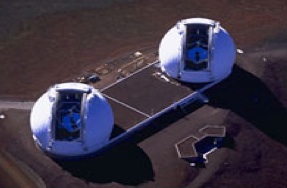Keck Interferometer

Keck Interferometer (KI)
In the first detection of an extragalactic source by O/IR interferometry, KI found a barely resolved ≤0.1 pc source in the nucleus of NGC 4151, ruling out models wherein most of the K-band nuclear emission is produced on ≥0.1 pc scales. This result is most consistent with the emission originating in the central accretion disk.
KI has probed the inner disk regions in young stellar objects including T Tauri stars, Herbig Ae/Be stars, and the older disk star TW Hya. These observations support the emission arising from the inner edge of the dust disk at the dust sublimation radius. The most massive YSOs, the Herbig Be sources, do not conform to this model but are consistent with a geometrically thin accretion disk.
KI time is available to UC, Caltech, UH,NASA and NOAO users (msc.caltech.edu/software/KISupport).
Keck Interferometer:
The Keck Interferometer (KI) is a NASA-funded project to combine the world's two largest optical telescopes, the 10-m Keck telescopes, as an interferometer. The KI project was carried out jointly by the Jet Propulsion Laboratory (Caltech), the Michelson Science Center (Caltech) and the W.M. Keck Observatory. KI was the first large-aperture interferometer and the first near-infrared
interferometer to observe an object outside our own galaxy (NGC 4151).
First fringes were obtained in 2001 and KI is facility-class instrument available to proposals from the Keck community.
The current observational modes are near-infrared visibility amplitude and mid-infrared nulling.
More information:
Instrument description:
http://planetquest.jpl.nasa .gov/Keck/keck_technology.cfm
Current sensitivity and proposal information:
http://msc.caltech.edu/softwar e/KISupport/
Science publications:
http://msc.caltech.edu/softwar e/KISupport/KI_biblio.html